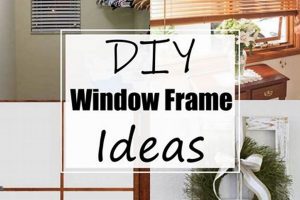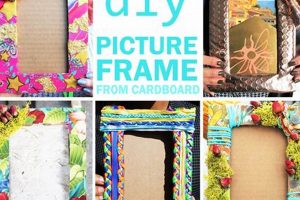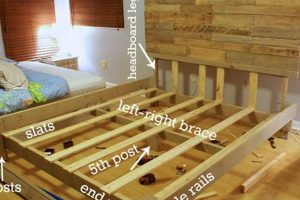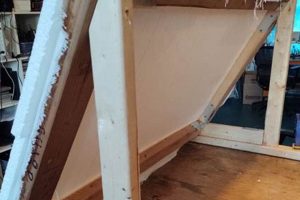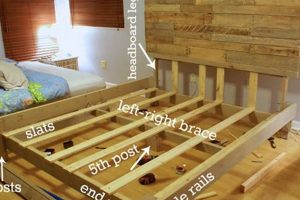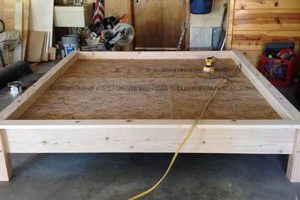Creating surrounds for reflective glass surfaces offers a realm of creative expression and personalization within interior design. Such projects encompass a wide variety of materials and techniques, enabling individuals to customize decorative elements to complement existing aesthetics or introduce unique visual statements. For example, repurposed materials like reclaimed wood, rope, or even mosaic tiles can be employed to construct visually interesting borders.
Enhancing the aesthetic appeal of a looking glass provides several advantages. It allows homeowners to integrate personalized art into their living spaces, reflects individual taste, and often presents a cost-effective alternative to purchasing pre-fabricated decorative mirrors. Historically, framing mirrors has been a craft practiced across cultures, with artisans utilizing locally sourced materials to adorn these functional and ornamental objects, reflecting regional styles and artistic sensibilities.
The subsequent discussion will explore various approaches to constructing decorative borders for reflective surfaces. This will include the selection of appropriate materials, essential construction techniques, and stylistic considerations to achieve desired visual outcomes, ultimately contributing to an enhanced interior environment.
Construction Advice for Reflective Surface Borders
The following suggestions offer guidance on achieving successful and aesthetically pleasing construction of decorative borders for reflective surfaces. Attention to detail and careful material selection are paramount.
Tip 1: Material Selection: Choose materials that complement the surrounding decor and are appropriate for the intended environment. Consider factors such as humidity, temperature, and potential wear and tear. For bathroom mirrors, moisture-resistant materials like treated wood or synthetic composites are advisable.
Tip 2: Accurate Measurement: Precise measurements of the reflective surface are crucial for ensuring a well-fitting border. Account for any desired overlap or reveal. A poorly measured frame will detract from the overall aesthetic and may compromise structural integrity.
Tip 3: Secure Attachment: Select an appropriate adhesive or mechanical fastening method for attaching the border to the glass. Mirror mastic is a recommended adhesive, providing a strong and permanent bond without damaging the reflective backing. Mechanical fasteners should be discreet and not compromise the mirror’s surface.
Tip 4: Mitering Corners: For rectangular or square borders, precise miter cuts at the corners are essential for a professional appearance. A miter saw is the preferred tool for achieving accurate angles. Alternatively, corner blocks can be employed for a simpler construction technique.
Tip 5: Surface Preparation: Ensure that the surface of the reflective surface is clean and free of debris before applying any adhesive or attaching the border. Isopropyl alcohol can be used to clean the glass surface without leaving residue.
Tip 6: Consistent Finish: Apply a uniform finish to the border material, whether it is paint, stain, or sealant. Multiple thin coats are preferable to a single thick coat, minimizing runs and ensuring even coverage. Proper drying time between coats is essential.
Tip 7: Consider Weight: Heavier frame materials require stronger mounting hardware to ensure the mirror remains securely affixed to the wall. Evaluate the weight of the finished piece and select appropriate anchors and hanging mechanisms.
Adhering to these guidelines promotes successful construction, resulting in a visually appealing and durable enhancement to the reflective surface. The careful application of these principles elevates the project from a simple undertaking to a refined and sophisticated decorative element.
The subsequent section will transition to exploring specific stylistic approaches, demonstrating how these construction techniques can be applied to achieve diverse aesthetic outcomes.
1. Material Selection
Material selection constitutes a foundational element in projects involving personalized reflective surface borders. The choice of material directly influences the project’s aesthetic appeal, durability, and overall cost. Inappropriate material selection can lead to structural failure, premature degradation, or a visual incompatibility with the surrounding environment. For instance, employing untreated softwood in a bathroom setting, prone to high humidity, will likely result in warping, mildew growth, and eventual disintegration of the frame. Conversely, selecting moisture-resistant materials like cedar or PVC composite would mitigate these risks and extend the lifespan of the finished product.
Beyond environmental factors, material selection also dictates the visual character of the completed border. Reclaimed wood can impart a rustic and organic aesthetic, while metallic materials such as aluminum or steel offer a modern and industrial feel. The chosen material also impacts the complexity of the construction process. Materials like lightweight balsa wood are easily cut and shaped, suitable for intricate designs, but they lack the structural robustness of hardwoods, necessitating careful consideration of the design’s scale and complexity. Using heavier material may require stronger attachment methods to ensure the reflective surface is securely mounted.
In conclusion, judicious material selection is paramount in the context of reflective surface border projects. A comprehensive understanding of material properties, environmental considerations, and desired aesthetic outcomes is essential for achieving a successful and enduring result. Neglecting this fundamental aspect can lead to compromised structural integrity, visual discordance, and ultimately, project failure. Proper material selection is therefore not merely a preliminary step, but an integral component of the entire creative process.
2. Structural Integrity
The stability and durability of a reflective surface border are paramount considerations. Compromised structural integrity not only presents a safety hazard but also detracts from the aesthetic appeal and longevity of the finished piece. Therefore, careful attention must be paid to the design and construction to ensure a robust and enduring outcome.
- Material Compatibility and Load Bearing
The selection of materials directly impacts the load-bearing capacity of the frame. Combining dissimilar materials with differing expansion coefficients can lead to stress fractures and eventual failure. For instance, attaching a heavy slate border to a lightweight fiberboard backing without adequate support may result in the fiberboard warping or breaking under the weight. Proper material selection and understanding their mechanical properties are crucial.
- Joint Construction and Fastening Methods
The method of joining frame components significantly affects overall strength. Weakly constructed joints are points of vulnerability and can lead to separation or collapse. Simple butt joints, while easy to execute, offer minimal resistance to stress. Stronger joinery techniques such as mortise-and-tenon, dovetail, or properly reinforced mitered joints provide significantly enhanced structural integrity. Furthermore, the selection of appropriate fasteners (screws, nails, adhesives) is critical to ensure lasting stability.
- Backing and Support Systems
The backing and support system play a vital role in distributing the weight of the reflective surface and border, preventing undue stress on any single point. A flimsy or inadequate backing can cause the entire assembly to warp, crack, or even detach from the wall. Reinforcing the backing with a rigid material like plywood or using strategically placed supports can significantly improve the overall structural integrity.
- Environmental Considerations
Environmental factors such as humidity and temperature fluctuations can affect the structural integrity of the frame over time. Wood, for example, expands and contracts with changes in moisture levels, potentially causing joints to loosen or crack. Selecting materials that are resistant to environmental degradation or applying protective coatings can help mitigate these risks and prolong the lifespan of the structure.
In conclusion, achieving adequate structural integrity in DIY reflective surface borders requires a holistic approach that considers material compatibility, joint construction, support systems, and environmental factors. By prioritizing these aspects, the creator can ensure a safe, durable, and aesthetically pleasing finished product that withstands the test of time.
3. Aesthetic Coherence
Achieving visual harmony is paramount when integrating a handcrafted reflective surface border into a pre-existing environment. The success of such projects hinges on establishing a clear relationship between the new addition and the surrounding decor, ensuring a sense of unity and intentionality.
- Style Compatibility
The frame’s design should resonate with the prevailing style of the room. A rustic wooden frame might complement a farmhouse-style interior, while a sleek metal frame would be more fitting for a modern aesthetic. Disregarding style compatibility can result in a jarring visual dissonance, detracting from the overall ambiance.
- Color Palette Integration
The chosen colors for the frame should harmonize with the existing color scheme. Employing complementary or analogous color palettes can create a sense of visual unity. Conversely, using clashing colors can disrupt the flow of the room and draw undue attention to the frame itself.
- Material Consistency
The materials used in the frame should be consistent with the materials present in the surrounding environment. Introducing a radically different material can create a sense of disjointedness. For instance, pairing a highly polished chrome frame with a room dominated by natural wood tones might appear incongruous.
- Scale and Proportion
The size and proportions of the frame should be appropriate for the size of the reflective surface and the dimensions of the wall on which it is mounted. A frame that is too large or too small can appear unbalanced and visually awkward. Careful consideration of scale is essential for achieving a harmonious composition.
Achieving aesthetic coherence in self-directed reflective surface border projects requires careful planning and execution. By considering style, color, material, and scale, the artisan can create a visually pleasing addition that enhances the overall aesthetic of the space. The ultimate goal is to create a seamless integration, where the frame appears as a natural and integral part of the existing environment, rather than a discordant afterthought.
4. Cost-effectiveness
The economic feasibility of constructing reflective surface surrounds is a significant factor for many individuals. The pursuit of affordability often drives the decision to undertake a project of this nature, prompting a comparative analysis of available options.
- Material Sourcing Strategies
Acquiring materials at a reduced cost is pivotal. Salvaged or repurposed resources, such as reclaimed wood or discarded moldings, offer substantial savings compared to purchasing new materials. Furthermore, strategic sourcing from discount retailers or online marketplaces can yield competitive pricing, directly impacting the overall expenditure.
- Labor Cost Reduction
The primary advantage of a do-it-yourself approach is the elimination of professional labor expenses. By personally executing the design and construction phases, individuals circumvent the often-significant costs associated with hiring a contractor or artisan. This self-sufficiency directly translates to a more economical outcome.
- Tool Investment Considerations
While a do-it-yourself project can reduce costs, it is important to consider if you already own the tools. The need to acquire specialized tools can offset some of the potential savings. However, a one-time investment in tools can prove economically beneficial over time if they are utilized for subsequent projects. Consider the initial tool investment versus long-term savings.
- Avoiding Customization Premiums
Pre-fabricated decorative mirrors often incur a premium for customized sizes, materials, or designs. By creating a surround, individuals can precisely tailor the dimensions and aesthetic to their specific needs and preferences without incurring the added expense of bespoke manufacturing.
The amalgamation of strategic material procurement, labor cost avoidance, mindful tool investment, and the circumvention of customization premiums contributes to the economic viability of self-directed reflective surface border construction. This convergence of factors underscores the potential for significant cost savings compared to purchasing commercially available alternatives.
5. Skill level
The attainment of successful outcomes in reflective surface border construction is inextricably linked to the artisan’s proficiency. A novice attempting a complex design may encounter challenges that compromise both the structural integrity and the aesthetic appeal of the finished product. Conversely, an experienced craftsman can execute intricate designs with precision, resulting in a durable and visually striking enhancement to the reflective surface.
The selection of materials and construction techniques should align with the individual’s capabilities. A beginner might start with a simple frame constructed from pre-cut lumber, using basic joinery techniques such as butt joints secured with screws. An experienced woodworker, on the other hand, might choose to utilize more advanced joinery methods like mortise-and-tenon or dovetail joints, resulting in a stronger and more visually refined frame. Similarly, the complexity of the design should reflect the artisan’s skill. Intricate carvings, mosaic patterns, or elaborate inlays are best left to those with the necessary expertise.
In essence, the individual’s skill level is a critical determinant of the complexity and sophistication that can be achieved in self-directed reflective surface border creation. An accurate self-assessment of one’s abilities is crucial for selecting a project that is both challenging and achievable, leading to a rewarding and aesthetically pleasing outcome. Overestimating one’s skills can lead to frustration and a substandard finished product, while underestimating one’s capabilities may limit the creative potential of the project.
Frequently Asked Questions
The following section addresses common inquiries regarding the creation of personalized reflective surface borders, offering concise and informative responses.
Question 1: What is the optimal adhesive for attaching a wooden surround to a glass surface?
Mirror mastic is generally considered the optimal adhesive for this application. This specialized adhesive is formulated to bond securely to glass surfaces without damaging the reflective backing. Alternative adhesives may contain solvents that can degrade the backing over time, leading to discoloration or delamination.
Question 2: What safety precautions should be observed when cutting glass or mirror materials?
Eye protection, such as safety glasses, is essential to prevent shards of glass from entering the eyes. Gloves are recommended to protect hands from cuts. It is also advisable to work in a well-ventilated area to avoid inhaling glass dust. Broken glass should be disposed of properly to prevent injury.
Question 3: How can mitered corners be accurately cut without a miter saw?
While a miter saw provides the most accurate cuts, a miter box and handsaw can be used as an alternative. The miter box provides a guide for cutting accurate 45-degree angles. Careful measurement and precise sawing are crucial for achieving tight-fitting corners.
Question 4: What type of finish is most durable for a decorative border in a bathroom environment?
A moisture-resistant finish is essential for bathroom applications. Polyurethane or epoxy-based finishes provide excellent protection against water damage and humidity. Multiple coats of finish are recommended to ensure thorough coverage and maximum durability.
Question 5: How can warping be prevented when using reclaimed wood for a frame?
Select reclaimed wood that is properly seasoned and kiln-dried to minimize moisture content. Apply a sealant or finish to all surfaces of the wood, including the back, to prevent moisture absorption. A stable backing material, such as plywood, can also be used to reinforce the frame and prevent warping.
Question 6: Is it necessary to prime bare wood before painting a border?
Priming is generally recommended to improve adhesion of the paint and create a uniform surface for the topcoat. A primer also helps to seal the wood, preventing it from absorbing the paint unevenly. This results in a smoother and more durable finish.
Adherence to these responses should significantly enhance the probability of a favorable outcome in reflective surface border endeavors. The incorporation of appropriate methodology and materials is paramount to project success.
The subsequent discussion will transition to exploring design trends, showcasing how these techniques can be applied to achieve cutting-edge visual outcomes.
Conclusion
The preceding exploration has elucidated diverse facets of decorative borders for reflective surfaces. From material selection and structural integrity to aesthetic coherence, cost-effectiveness, and skill level considerations, a comprehensive understanding of these elements is paramount for successful project execution. Key points include the necessity of appropriate adhesive selection, safety precautions when working with glass, accurate cutting techniques, and durable finishing for specific environments.
Effective utilization of this information enables individuals to enhance their living spaces through personalized artistic expression. Mastery of these techniques transforms a commonplace object into a unique reflection of individual style, contributing meaningfully to the overall aesthetic of a home or environment.


